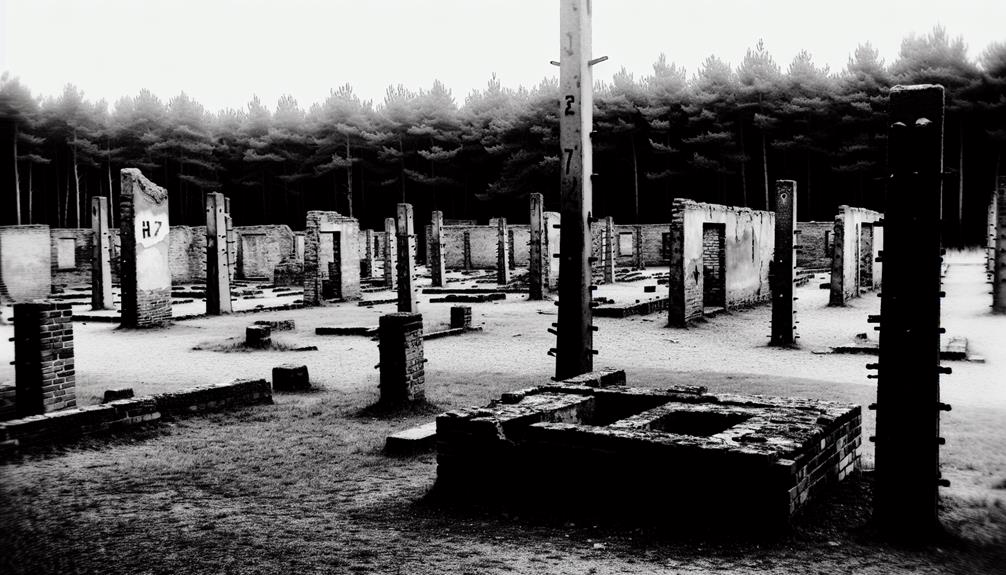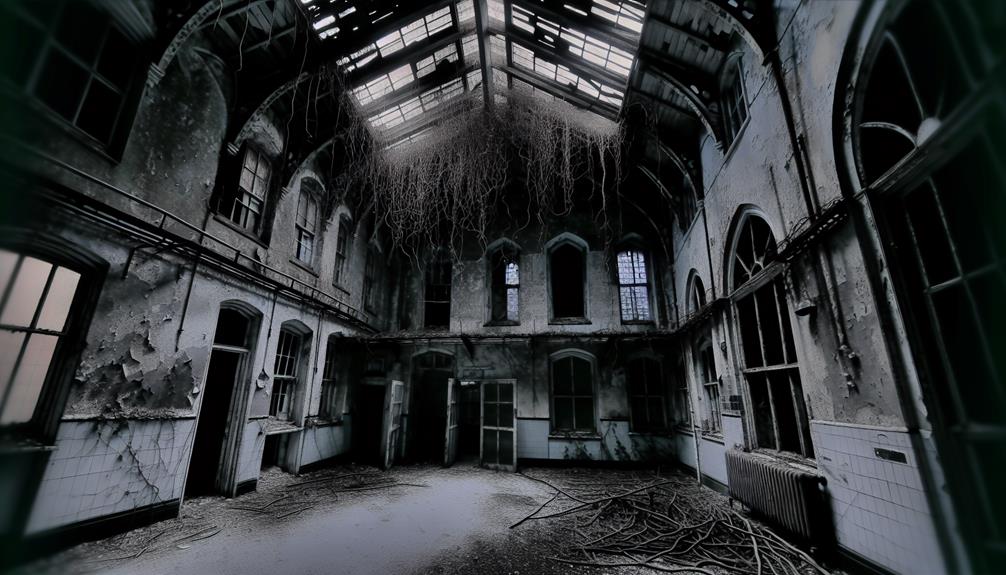The haunting echoes of suffering and survival resonate within the confines of Bergen-Belsen, a place entrenched in the annals of history for its profound significance during World War II. As we peer through the veil of time to uncover the narratives etched within its barbed wire fences, a tapestry of human endurance and tragedy unfolds before us. The stories that emerge from this solemn ground are not merely accounts of despair but demonstrations of the indomitable human spirit in the face of unimaginable adversity. In exploring the depths of Bergen-Belsen, we are compelled to confront the complexities of human nature and the enduring quest for resilience in the midst of unspeakable horrors.
Key Takeaways
- Stories of suffering include severe overcrowding, lack of sanitation, and disease outbreaks.
- Survivors demonstrated resilience by helping each other, medical staff worked with limited resources.
- Liberation brought hope amidst widespread trauma and poor health among survivors.
- Bergen-Belsen's history serves as a stark reminder of war atrocities and the resilience of the human spirit.
- The camp's legacy emphasizes standing up against injustice and never forgetting the atrocities committed.
The Origins of Bergen-Belsen
The establishment of Bergen-Belsen concentration camp in northern Germany during World War II was a consequence of the escalating persecution and systematic annihilation of individuals deemed undesirable by the Nazi regime. This institution, initially intended for prisoners of war, became a site of horrific Nazi atrocities, where thousands of lives were lost, and countless others endured unimaginable suffering. Prisoner testimonies provide chilling accounts of the deplorable conditions and inhumane treatment that characterized Bergen-Belsen.
As the Nazi regime tightened its grip on power, individuals considered threats to their ideology were targeted for imprisonment, torture, and extermination. Bergen-Belsen played a significant role in this machinery of oppression, evolving from a prisoner of war camp to a place where political dissidents, Jews, Romani people, and others deemed 'undesirable' were incarcerated. The camp's population swelled as the war progressed, leading to severe overcrowding, malnutrition, and rampant disease.
Prisoner testimonies vividly capture the harrowing experiences of those trapped within Bergen-Belsen's barbed wire fences. Stories of families torn apart, daily struggles for survival, and the constant fear of arbitrary violence paint a stark picture of the camp's grim reality. Despite the immense challenges they faced, many prisoners demonstrated remarkable resilience and solidarity in the face of unimaginable adversity. The origins of Bergen-Belsen reflect a dark chapter in human history, underscoring the importance of bearing witness to the atrocities committed during this period.
Life Inside the Concentration Camp
Amidst the bleak confines of Bergen-Belsen concentration camp, a harrowing existence marked by suffering, deprivation, and resilience unfolded for its imprisoned inhabitants. The daily life inside the camp was a constant struggle against malnutrition, disease, and inhumane living conditions. Despite these challenges, individuals displayed remarkable survival tactics and unwavering human spirit in the face of unimaginable adversity.
| Challenges Faced | Survival Tactics | Impact on Human Spirit |
|---|---|---|
| Malnutrition | Sharing meager rations and creating communal support systems | Despite physical weakness, individuals showed remarkable solidarity and care for one another |
| Disease | Making herbal remedies and caring for the sick within limitations | Resilience was showcased through the determination to fight illness and support fellow prisoners |
| Inhumane Conditions | Finding moments of solace in small acts of kindness and shared memories | Even in the darkest times, the human spirit clung to fragments of hope and connection |
The dire circumstances within Bergen-Belsen demanded extraordinary measures for survival. The ability to adapt, the strength to endure, and the compassion to support one another were all vital components of life inside the camp. The human spirit, though tested to its limits, persisted in the face of overwhelming despair, shining a light on the resilience and courage that can emerge even in the darkest of times.
Acts of Resistance and Courage
Within the confines of Bergen-Belsen, acts of defiance and bravery emerged as individuals sought to resist the dehumanizing conditions and uphold their dignity in the face of unimaginable atrocities. In the midst of such darkness, sparks of courage illuminated the camp, reminding everyone that the human spirit is indomitable. Here are some examples of resistance and bravery that shone through the despair:
- Secret Schools: Despite the risks involved, some prisoners clandestinely organized educational activities to make sure that knowledge and hope were passed on to younger inmates, defying the oppressive environment that sought to extinguish intellect and spirit.
- Cultural Performances: Through clandestine theater productions, musical performances, and poetry readings, inmates found solace in art, using creativity as a form of resistance against the dehumanization they faced daily.
- Support Networks: Underground networks were established to share scarce resources, provide emotional support, and plan escapes. These acts of solidarity were a proof of the resilience and compassion that persisted even in the bleakest of circumstances.
- Small Acts of Defiance: Whether it was sharing a piece of bread, offering a kind word, or standing up for one another, these small acts of defiance against the cruelty of the guards upheld a sense of humanity and dignity amidst the inhumanity surrounding them.
Liberation and Its Aftermath
Upon the liberation of Bergen-Belsen, a complex web of challenges and emotions unfolded, shaping the immediate aftermath and long-term repercussions for survivors and the world at large. The survivors faced the challenging task of rebuilding their shattered lives and communities in the wake of unspeakable atrocities. The physical scars of malnutrition, disease, and abuse were evident, but the psychological trauma ran even deeper, leaving lasting wounds that would take decades to heal.
The liberation brought a mix of emotions for the survivors – relief, disbelief, and profound grief for those who perished. While they were free from the horrors of the camp, the journey to recovery was just beginning. Many struggled to find their place in a world that had been forever changed by the war.
Rebuilding communities in the aftermath of Bergen-Belsen was a formidable challenge. Families had been torn apart, and the social fabric that once held them together was frayed. The survivors had to lean on each other for support, forming new bonds forged in the crucible of their shared experiences.
The psychological trauma inflicted by the Holocaust lingered long after the physical wounds had healed. Survivors grappled with survivor's guilt, nightmares, and a deep sense of loss that colored their interactions with the world. The liberation of Bergen-Belsen marked the end of one chapter of suffering but the beginning of a new struggle for healing and reconciliation.
Legacy and Lessons Learned
The enduring legacy of Bergen-Belsen encompasses profound lessons learned from the depths of human suffering and resilience in the face of unimaginable atrocities. The impact of this harrowing chapter of history resonates through time, shaping our understanding of humanity's capacity for both cruelty and compassion.
Here are four key lessons that the legacy of Bergen-Belsen imparts:
- Never Forget: The impactful remembrance of the suffering endured in Bergen-Belsen serves as a stark reminder of the consequences of hatred and intolerance. It compels us to confront the darkest aspects of human nature and reaffirm our commitment to ensuring such atrocities are never repeated.
- Strength in Adversity: The enduring resilience displayed by survivors of Bergen-Belsen teaches us about the indomitable human spirit. Despite facing unimaginable horrors, many found the strength to survive, rebuild their lives, and share their stories of courage and survival.
- Importance of Empathy: The legacy of Bergen-Belsen underscores the critical importance of empathy and compassion in the face of adversity. It prompts us to cultivate understanding, kindness, and solidarity towards others, especially those who have experienced trauma and suffering.
- Promoting Tolerance and Justice: Reflecting on the lessons learned from Bergen-Belsen, we are reminded of the crucial role each individual plays in promoting tolerance, justice, and equality. By standing against discrimination and injustice, we honor the legacy of those who suffered and perished in the camp, striving to create a more just and compassionate world.
Frequently Asked Questions
How Did Survivors Cope With the Psychological Trauma After Liberation?
Survivors of traumatic experiences such as liberation from concentration camps often faced significant psychological challenges. Coping mechanisms varied, with many relying on post-trauma therapy and mental health support to navigate the aftermath of liberation.
Survivor resilience played an essential role in helping individuals rebuild their lives and process the unimaginable suffering endured during their captivity. The journey towards healing necessitated a combination of professional assistance and personal strength to overcome the lasting effects of such harrowing experiences.
Were There Any Attempts to Rebuild Bergen-Belsen After Its Closure?
After its closure, there were limited attempts to rebuild Bergen-Belsen. Reconstruction efforts focused on restoring basic infrastructure and establishing a memorial site to honor the victims.
Historical preservation was paramount in ensuring the memory of the atrocities committed at the camp was not forgotten. Despite the challenges, efforts were made to create a place of remembrance and reflection for future generations to learn from the tragic events that occurred there.
What Happened to the Former Guards and Staff of the Camp?
Following the closure of the camp, the fate of the former guards and staff of Bergen-Belsen varied. Many were tried and faced justice for their roles in the atrocities, while others sought rehabilitation through programs aimed at understanding the implications of their actions.
The pursuit of justice served as a pivotal moment in reckoning with the past, offering a chance for both accountability and potential redemption in the face of unimaginable suffering.
Are There Any Memorials or Monuments Dedicated to the Victims?
Memorial sites and remembrance events play a vital role in honoring the victims of historical tragedies. These places serve as a poignant reminder of the suffering endured and the lives lost.
Through memorials and monuments, communities come together to pay tribute, educate, and guarantee that the memories of those who perished are never forgotten. Such sites provide a space for reflection, contemplation, and a collective commitment to never repeat the atrocities of the past.
How Has the Local Community in Bergen-Belsen Addressed Its Dark History?
In addressing its dark history, the local community in Bergen-Belsen has actively engaged in community healing through educational initiatives.
For example, local schools have integrated Holocaust education into their curriculum, fostering empathy and understanding among students.
Conclusion
To sum up, the harrowing history of Bergen-Belsen serves as a stark reminder of the suffering and resilience witnessed during the Holocaust.
Through the stories of survival, acts of kindness, and eventual liberation, we are reminded of the strength of the human spirit in the face of unimaginable adversity.
The legacy of Bergen-Belsen urges us to never forget the atrocities that occurred there and to continue to learn from the lessons of the past.


